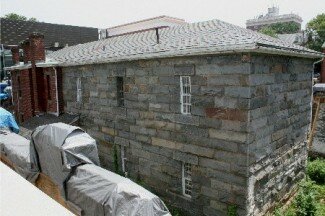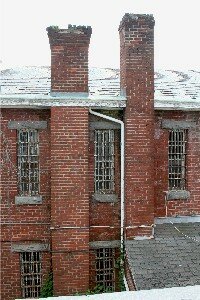Jailhouse talk: County developing re-use plan
 The old stone Albemarle County Jail stands behind an 18-foot brick wall that surrounds the structure.
The old stone Albemarle County Jail stands behind an 18-foot brick wall that surrounds the structure.PHOTO BY DAVE MCNAIR
Now that the $20 million renovation of the old Juvenile & Domestic Relations Court is almost finished, another historic building in need of repair stands in sharp contrast to the new construction, boxed in as it is by a brand new parking garage: the old Albemarle County Jail. Although the J&DR court project was a joint venture between the County and the City, the price tag did not include any work on the old jail, and now it's up to the County to figure out what to do with it.
According to Marc Wagner at the Virginia Department of Historic Resources, the deteriorating jail is of far more historical significance than the nearby J&DR court house.
"The courthouse is interesting," he says, " but the jail is really unusual." Indeed, with its huge block stone walls and thin barred windows, it looks like something out of the Middle Ages. But believe it or not, the City was still using it to hold prisoners in the 1970s.
"I used the wall as a backstop for hitting tennis balls when I was taking YMCA lessons at the McIntire Tennis Courts, since reborn as a skateboard park," says Antoinette Roades, a local preservationist and historian, whose family lived right next to the jail in the 1960s. "If I hit a wild shot over the wall, a prisoner would throw it back."
The Albemarle County Jail No. 5, as it was originally called, was built by George Wallace Spooner in 1876. Spooner, who also happened to be city manager, also built the Mount Zion Baptist Church on Ridge Street and was tapped to rebuild the Rotunda after it burned in 1895, a job he would eventually lose to architect Stanford White. In 1886, Spooner added the brick jailer's house that stands today.
Clearly, Spooner wanted his jail to send a message. In addition to three-foot thick stone walls, reinforced steel doors, and an 18-foot brick wall surrounding the prison yard, the jail also featured an iron "cage" on the ground floor with six cells. The "cage" was reserved for black prisoners, while white males were kept in the original cells, and women of both races were kept on the second floor.
"Now this is what a jail should look like," joked then Albemarle County Sheriff Terry Hawkins in a 1992 Daily Progress story on the jail. "You don't want to come back to this." According to Roades, the jail was a nightmarish place, but there was a reason for one prisoner to come back.
 The old stone jail, and the brick jailer's house in front of it, stand in sharp contrast to the newly renovated J&DR court house on High Street.
The old stone jail, and the brick jailer's house in front of it, stand in sharp contrast to the newly renovated J&DR court house on High Street.PHOTO BY DAVE MCNAIR
"For years, the jailer was a nasty man who beat prisoners," says Roades. "I heard beatings from my bedroom window. I heard prisoners' cries, too. One day, though, the nasty jailer got his own sentence. He dropped dead of a massive heart attack on the jail porch."
Shortly after the new jailer took charge, Roades recalls that a prisoner escaped by running up a coal pile on the inside of the west wall, pulling himself up and over, then running down a sprawling old apple tree next to her house and out to the street.
"He was at large for a matter of weeks," says Roades. "On a particularly cold Thanksgiving Day, however, he returned and knocked on the jailer's front door and asked to be let back in because the new jailer's wife, a really sweet and motherly woman, was an ace cook, and the escapee couldn't imagine missing her dinner."
"Right now the county is responsible for the building," says County spokesperson Lee Catlin, "and for keeping the grounds from getting unsightly and keeping the building from deteriorating any further."
However, Catlin says a re-use study is currently underway, and that an RFP, a Request for Proposal, for re-use has been issued.
"We've solicited proposals from architecture and engineering firms to help us figure out the options," says County project manager Ron Lilley, "and we hope to have one of the firms selected within the next month or so."
Lilley says that ideas for the jail's use haven't really been developed yet, but he hopes to have several concepts ready for public discussion by the end of the year.
Of course, even after the re-use study is done and the public weighs in, there's the matter of paying for it. Lilley thinks it could possibly be put into the County Capital Improvements Plan for a few years out, once a decision is made about what to do with it, but he says that's only a guess right now. "At this point, there's just not a whole lot known," he says.
 "Someone with a good imagination could do something really wonderful there," says one local architect.
"Someone with a good imagination could do something really wonderful there," says one local architect.PHOTO BY DAVE MCNAIR
However, the consensus among many local preservationists and architects, including Roades and Charlottesville/Albemarle Historic Society president Steven Meeks, is that the jail should be handed over to the Historical Society for use as a museum.
"I believe it should be both a permanent local history museum, of which this allegedly ever-so-historic community has no such thing," says Roades," and a state-of-the-art storage facility for the conservation-challenged collection of the Historical Society."
In fact, Meeks has already pitched the idea to city and county officials, and serves on the jail's reuse committee. As Meeks points out, the Society has already been using the jail for years as a stop on its summer walking tours and the annual Spirit Walk.
"I envision the old jailor's house housing an exhibit on the early history of the community and the jail itself would remain as it is, maybe with some archival storage area for the Society," says Meeks. "The are lots of examples around the Commonwealth where old jails have been given over to use by the local historical society for use as a local history museum."
Local architect Don Swofford agrees. Swofford, who has restored three old jails in Goochland County, Fluvanna, and Charlotte County, says all of them were turned into museums.
"They make great museums because their walls are so thick," says Swofford, " and so they're easy to heat and cool. And the brick jailer's house would make a great office for the Historical Society."
"The cells are perfect for gallery displays," says architect and preservationist Brian Broadus, though he's open to ideas from the public. "Who knows, maybe it could be a restaurant. And the prison yard could be nice as an outdoor space within the building. Someone with a good imagination could do something really wonderful there."
Swofford and Broadus say they've also heard ideas about turning the jail into offices for a non-profit, like Habitat for Humanity. Either way, Swofford thinks the unusual roof, thick walls, and thin windows would create a number of unique architectural challenges.
"Of course, the building is also wrapped up in the McCue hanging, Virginia's last public hanging," Broadus adds, "and I think that history needs to be preserved."
Indeed, at the turn of the century, the jail served as the setting for the final act of Charlottesville's most famous murder mystery, which was re-told in a 2003 Hook cover story, "Halloween mystery: 99 years later, the McCue murder," the tale of a 1904 murder of the wife of Charlottesville mayor Sam McCue.
McCue, whom some believe was innocent–- the evidence against him was largely circumstantial –- died slowly on the jail gallows one icy cold February day, kicking and struggling for nearly 20 minutes after the trap door was thrown, the result of a poorly-placed hangman's knot. According to news archives, Charlottesville was the center of an early 20th Century version of a media frenzy leading up to the execution. Three years later, the state legislature would officially ban public hanging, making McCue's in 1905 the last in Virginia history.
Former jail neighbor Roades also recalls looking out every Saturday morning to see the sad-eyed assembly of family members–- wives, children, parents, grandparents, brothers, sisters–- waiting on the walkway down from High Street to see inmates for brief visits. Years later, she discovered that her great-great grandfather was paid by then-jailer Allen Bacon to make repairs on the building several times in the 1870s.
After additional research, Roades says she also discovered that the only local lynching of the 19th century occurred when a band of "otherwise solid citizens" pulled a presumed murderer–- who was white, says Roades, as were his two victims–- out of the jail at night, despite the presence of state militia guard. The man was reportedly strung up at a residence called The Farm (once used by General George Custer as his headquarters during the Union occupation of Charlottesville) on what is now East Jefferson Street.
Given the fact that Roades recalls hearing beatings in the 1960s, one can only imagine what else might have happened at the old jail in the 19th century.
"I can say with complete confidence that the old county jail has more ghosts per square inch than most any other structure in town or county," says Roades, "a factor that all by itself should make it a history center."
June 22, 2009 9:46am
14 comments
A small boy is sent to bed by his father.
Five minutes later: "Da-ad..."
"What?"
"I'm thirsty. Can you bring me a glass of water?"
"No. It's too expensive! Lights out."
Five minutes later: "Da-aaaad..."
"WHAT?"
"I'm THIRSTY... Can I have a glass of water??"
"I told you NO! It's too expensive! If you ask again I'll have to spank you!!
"Five minutes later... "Daaaa-aaaad..."
"WHAT??!!"
"When you come in to spank me, can you bring me a glass of water?"
Does anyone really think it's a good use of tax payers' money to spend millions of dollars to renovate the complex for a restaurant?
I do not mean to imply that I wish to see the complex torn down.
Please just tear it down. It was a jail. Tear it down. Quit wasting taxpayer money. The cost to renovate to an alternative use is greater than the cost of new construction.
The fate of this wonderful historic building is in the hands of a County that has no preservation plan in place? Hope the City will lead the way on this project since their track record is much better (though FAR from perfect!)
I don't want to see the building altered, But, Cville, I think that is a very good idea! I would love to eat there. The problem, as it is surrounded by a court house, they would probably not allow a bar.
plop, how many millions should government spend so that a restaurant can be housed there, or is the sky the limit? Should the restaurant be privately or government owned?
I just want to see members of the public enjoy the place, and also gain access.
maybe he can dump some money into it, get it halfway renovated, and then leave it....
It's such a cool building with marvelous thick walls. Nobody builds using that sort of quality these days. I think it should be a museum, or something similar for educational purposes and the common good. There's a glut of entertainment and dining options downtown already.
Raze, with your great appreciation of historic structures, I'll bet you're a real buzz kill on European vacations, aren't you?
@cc, Oh, I agree wholeheartedly. I just wish I could be the jailer.
Let's make it a museum! Warrenton turned its small jail into a museum and included a room with antique medical and dental exhibits. Cool!
It would make a great place for the Rivanna Water & Sewer Authority to meet! We might even let them out eventually.
I Agree. The County has recently looked the other way as other older historic homes are maimed or entirely destroyed. VERY SAD AND inexcusible. A very poor showing indeed!